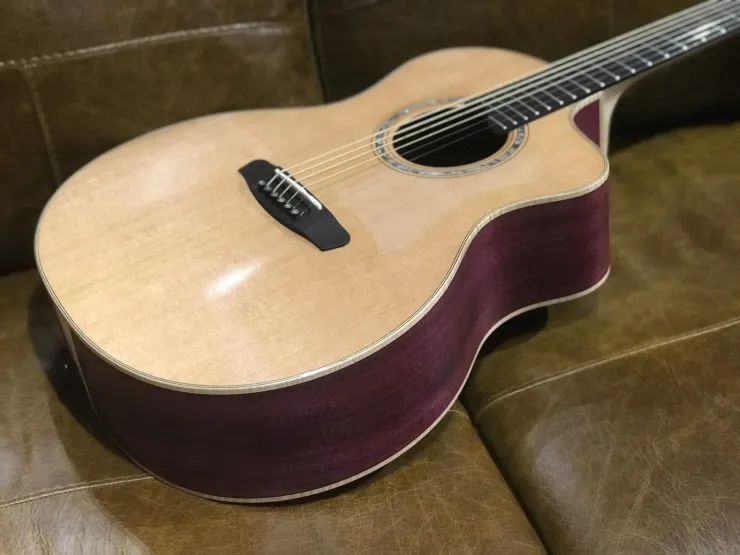What Is Purpleheart?
Coming from the Peltogyne genus of trees, purpleheart (also known as amaranth) is a dense tropical hardwood that’s native to the rainforests of Central and South America, particularly Brazil. Aside from its outstanding durability, one of the wood’s biggest attractions is its colourful appearance - in fact, the name is quite literal!
Underneath its creamy white sapwood, the tree’s heartwood is a light purplish brown when first cut. However, after being exposed to the air for a short while, the heartwood takes on its famous deep purple colour. Unfortunately, though, this fantastic colour doesn’t last forever. Ageing and exposure to UV light eventually turn the wood a deep, purplish brown.
How Is Purpleheart Used in Guitars?
As an incredibly dense wood, purpleheart certainly has some great applications in guitar making. That said, it’s not the right choice for every component.
With its massive density, purpleheart is a heavy wood - around 30% heavier than the not-so-lightweight mahogany, for instance. This, together with the wood’s tendency to split when worked, means that it isn’t a great choice for solid guitar bodies. Potentially, you could use it as a top wood, but there are lighter, easier-to-work alternatives with similar sound profiles, like maple.
In acoustics, purpleheart is a great choice for back and side wood. Offering a well-balanced tone with warm bass, clear highs, and well-pronounced midrange, the wood also has excellent clarity and projection. However, the time and care that the wood demands mean big-name guitar brands don’t often consider using it in bodies.
The wood’s physical strength means it’s suitable for necks. However, given its weight, a pure purpleheart neck could be susceptible to neck dive, so it more frequently appears as part of a laminated neck. Ultimately, you’re most likely to encounter the wood on a fretboard. Here, its incredible strength and projection can really shine, while less work is required to prepare the wood for this application.
How Do Purpleheart Guitars Sound?
Purpleheart offers a tonal register as rich and deep as the wood’s colour. It’s bright and warm, with brilliant highs and mids yet a well-rounded and responsive bass. If it were lighter and less challenging to work with, you would almost certainly see a lot more of it!
The wood’s natural density creates a longer, more pronounced sustain, with each note able to resonate fully. Moreover, its hardness results in incredible projection, offering power and range that’s suitable for both solo and ensemble performances.
Additionally, the wood’s nuanced harmonics and dynamic range can add complexity to a guitar’s sound. Whether strumming chords or fingering intricate solos, Purpleheart responds with exceptional clarity and tonal fidelity.
Is Purpleheart Sustainable?
Protecting the environment has never been more critical than it is today, and, unfortunately, guitar manufacturing is not immune. Many classic tonewoods, like rosewood and ebony, are now considered at risk, leading to the adoption of new, more sustainable alternatives. But how does purpleheart measure up?
As a species found predominantly in the tropical rainforests of Central and South America, Purpleheart is subject to the pressures of deforestation and the demand for rare woods. However, there have been strides in sustainable forestry practices, with certifications such as the Forest Stewardship Council (FSC) playing a crucial role in ensuring that the wood is harvested responsibly. Moreover, the genus is not listed in the CITES Appendices, while the most commonly harvested Peltogyne species also do not appear on the IUCN Red List.
Manufacturers prioritising sustainability in their sourcing policies can offer ethically produced purpleheart guitars, meaning the wood is an acceptable choice for the environmentally conscious guitarist.
Maintenance and Durability
To paraphrase Stan Lee: with great density comes excellent durability, and this is undoubtedly true of purpleheart. The wood’s resilience makes it an excellent choice if longevity and robustness are high on your priority list. Whether part of a neck or on the fretboard, this wood can take a punch - it shouldn’t present a problem, no matter your level of playing, whether you’re a road warrior or a bedroom noodler.
Furthermore, maintaining a purpleheart guitar is not overly burdensome. Again, the wood’s resilience, combined with its good resistance to wear, humidity, and temperature fluctuations, means you don’t need to do too much to keep your guitar sounding great. Just treat it like you would any other hardwood.
When you change your strings, wipe your fretboard with a rag, maybe using a little isopropyl alcohol for tough dirt. It can be a dry wood though, so a little good quality fretboard oil wouldn’t be amiss.
Pros and Cons
If purpleheart sounds like something you need to try, then you’re in luck - more and more manufacturers are utilising the wood in their models. However, take a quick look at our pros and cons before you make your final decision:
Pros
- Incredible density
- Well-balanced tone
- Excellent clarity and projection
- Relatively sustainable
Cons
- Difficult to work
- Heavy wood limits its guitar applications
- Can be more expensive
- Sustainability efforts may limit its availability
Is Purpleheart a Good Tonewood?
Traditionally, manufacturers and, in turn, guitarists have favoured woods like spruce, mahogany, and maple for their proven acoustic properties. However, whether due to sustainability efforts or just trying to stand out from the crowd, more manufacturers than ever before are experimenting with exciting new tonewoods. Purpleheart, with its dense, hard nature, is one such tonewood, bringing a unique sonic profile to the table and potentially offering a richer, more resonant sound with excellent sustain.
However, its use as a tonewood is not without controversy. Its critics argue that the wood’s density can sometimes lead to an overly bright or harsh sound, lacking the warmth provided by more conventional tonewoods. Furthermore, purpleheart’s sheer hardness poses challenges in guitar construction, potentially affecting the instrument’s responsiveness and dynamic range.
Despite these concerns, innovative guitar makers and adventurous musicians are increasingly drawn to the wood’s distinct qualities and visual appeal. However, the final judgement on whether purpleheart is a good tonewood ultimately comes down to personal preference.
Find Your Perfect Purpleheart Guitar
Ready to explore the unique qualities of purpleheart for yourself? Discover your perfect match with our comprehensive Finder tool. Whether you’re curious about the sonic characteristics of purpleheart or other exotic tonewoods, our tool simplifies your search by tailoring options to your personal preferences. Start your search today and find out just how easy we make finding your perfect guitar!

